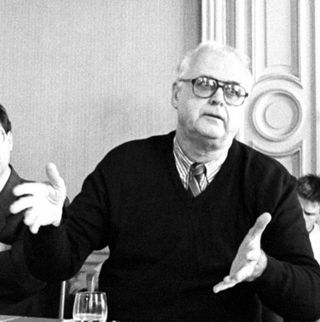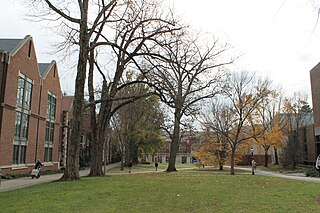
Peter David Eisenman is an American architect, writer, and professor. Considered one of the New York Five, Eisenman is known for his high modernist and deconstructive designs, as well as for his authorship of several architectural books. His work has won him several awards, including the Wolf Prize in Arts.
Charles Willard Moore was an American architect, educator, writer, Fellow of the American Institute of Architects, and winner of the AIA Gold Medal in 1991. He is often labeled as the father of postmodernism. His work as an educator was important to a generation of American architects who read his books or studied with him at one of the several universities where he taught.

Graduate School of Architecture, Planning and Preservation (GSAPP) is the architecture school of Columbia University, a private research university in New York City. It is regarded as an important and prestigious architecture school. It is also home to the Masters of Science program in Advanced Architectural Design, Historic Preservation, Real Estate Development, Urban Design, and Urban Planning.

Werner Seligmann was an architect, urban designer and educator.

Sir Peter Cook is an English architect, lecturer and writer on architectural subjects. He was a founder of Archigram, and was knighted in 2007 by the Queen for his services to architecture and teaching. He is also a Royal Academician and a Commandeur de l'Ordre des Arts et des Lettres of the French Republic. His achievements with Archigram were recognised by the Royal Institute of British Architects in 2004, when the group was awarded the Royal Gold Medal.

John Quentin Hejduk was an American architect, artist and educator from New York City. Hejduk studied at the Cooper Union School of Art and Architecture, the University of Cincinnati, and the Harvard Graduate School of Design. He worked in several offices in New York including that of I. M. Pei and the office of A.M. Kinney. He established his own practice in New York City in 1965.
Preston Scott Cohen is a professor of Harvard Graduate School of Design (GSD). In 2004, he established a partnership with two registered architects, Amit Nemlich and Gilles Quintal, and became the Design Principal of Preston Scott Cohen, Inc. based in Central Square Cambridge, Massachusetts. Preston Scott Cohen, Inc. is renowned for the design of cultural, educational, commercial buildings and urban design projects around the world. Projects include the Sarmiento Performing Arts Center in Bogota, Colombia; a new building for Taubman College at the University of Michigan; the Taiyuan Museum of Art in Taiyuan, China; the Datong City Library; the Amir Building, Tel Aviv Museum of Art; and the Goldman Sachs Canopy in New York. The firm is also well known for non-profit projects including the Cape Rep Theater, Temple Beth El in Springfield, MA, and the Detroit Chabad. Cohen has received numerous honors including induction as an academician at the National Academy of Art, five Progressive Architecture Awards, first prizes for seven international competitions and an Academy Award from the American Academy of Arts and Letters. Cohen is the author of Lightfall, The Return of Nature (2015), Contested Symmetries (2001), and numerous theoretical essays on architecture. His work has been widely exhibited and is held in numerous museum collections.

The University of Cincinnati College of Design, Architecture, Art, and Planning (DAAP) is an arts and architecture college of the University of Cincinnati in Cincinnati, Ohio. It was initially established as the School of Applied Art in 1926.

Michael David Sorkin was an American architectural and urban critic, designer, and educator. He was considered to be "one of architecture's most outspoken public intellectuals", a polemical voice in contemporary culture and the design of urban places at the turn of the twenty-first century. Sorkin first rose to prominence as an architectural critic for the Village Voice in New York City, a post which he held for a decade throughout the 1980s. In the ensuing years, he taught at prominent universities around the world, practiced through his eponymous firm, established a nonprofit book press, and directed the urban design program at the City College of New York. He died at age 71 from complications brought on by COVID-19 during the COVID-19 pandemic.

Jeffrey Kipnis is an American architectural critic, theorist, designer, film-maker, curator, and educator.

Karen Bausman is an American architect. She has held the Eliot Noyes Chair at the Harvard Graduate School of Design at Harvard University and the Eero Saarinen Chair at Yale School of Architecture at Yale University, the only American woman to hold both design chairs.

Beatriz Colomina is an architecture historian, theorist and curator. She is the founding director of the Program in Media and Modernity at Princeton University, the Howard Crosby Butler Professor of the History of Architecture and director of graduate studies in the School of Architecture.

Alexander Tzonis is a Greek-born architect, author, and researcher. He has made contributions to architectural theory, history and design cognition, bringing together scientific and humanistic approaches in a synthesis. Since 1975, he has been collaborating in most projects with Liane Lefaivre. In 1985, he founded and directed Design Knowledge Systems (DKS), a multidisciplinary research institute for the study of architectural theory and the development of design thinking tools at TU Delft. Tzonis is known for his work on the classical canon, history of the emergence and development of modern architectural thinking, creative design by analogy, and introducing the idea of critical regionalism.

Sarah M. Whiting is an American architect, critic, and academic administrator. Whiting is currently Dean and Josep Lluís Sert Professor of Architecture at Harvard Graduate School of Design, in addition to being a founding partner of WW Architecture, along with her husband, Ron Witte. She previously served as Dean and William Ward Watkin Professor of Architecture at Rice School of Architecture. In addition to her work as an academic administrator, Whiting is most commonly identified as an intellectual figure within the field of architecture's "post-critical" turn in the early 2000s.
Mónica Ponce de León is a Latina architect, educator, and dean of the Princeton University School of Architecture.
The history of Rensselaer Polytechnic Institute (RPI) spans nearly two hundred years beginning with its founding in 1824. RPI is the oldest continuously operating technological university in both the English-speaking world and the Americas. The Institute was the first to grant a civil engineering degree in the United States, in 1835. More recently, RPI also offered the first environmental engineering degree in the United States in 1961, and possibly the first ever undergraduate degree in video game design, in 2007.
Alan Harold Colquhoun was an English architect, historian, critic and teacher.

Princeton University School of Architecture is the name of the school of architecture at Princeton University. Founded in 1919, the School is a center for teaching and research in architectural design, history, and theory. The School offers an undergraduate concentration and advanced degrees at the master's and doctoral levels.

David Mohney FAIA is an American architect, urbanist, writer, and dean at Kean University and Wenzhou-Kean University.













